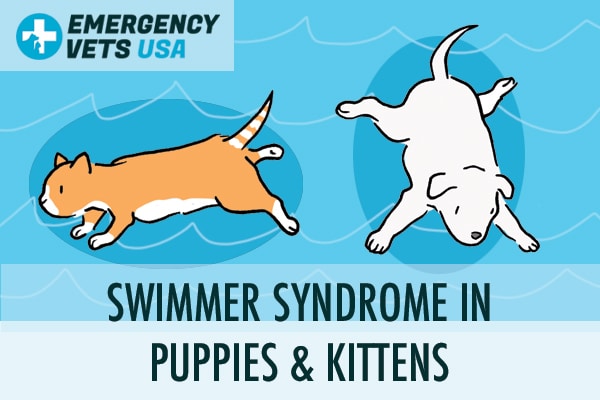Swimmer Syndrome In Puppies & Kittens
Swimmer syndrome is a congenital condition that impacts the tiniest of cats and dogs.
With being fairly common in kittens and puppies, there is a high chance of you coming in contact with this condition if you work often with growing furry friends.
Swimmer syndrome can deeply impact an animal’s mobility, so it is essential to act fast when it is diagnosed.
In this article we will discuss the details of swimmer syndrome in puppies and kittens, and introduce you to the many rehab options available to these babies.

What Is Swimmer Syndrome In Puppies and Kittens?
Swimmer syndrome is a congenital abnormality that impacts both kittens and puppies alike.
This condition causes a pet’s limbs to splay out to the side, often unable to put their feet underneath them with normal movement.
This makes it extremely challenging for them to walk, with some being unable to stand on their own at all.
Swimmer syndrome is known to cause a frog-like stance as they attempt to move, most often impacting the back legs.
Though kittens and puppies are born with this condition, you will not be able to properly diagnose it until they are weeks old.
When Will You Notice Swimmer Syndrome?
Though some experienced caregivers may suspect swimmer syndrome at an early age, it should not be assumed until they are at least 3 weeks old.
Kittens and puppies will begin to develop muscles that help them stand at around 3 weeks, allowing you to observe their normal gait.
If at this point their limbs are splayed outward and have an abnormal positioning, you can officially diagnose swimmer syndrome.
When Should You Correct Swimmer Syndrome?
You should always begin to correct swimmer syndrome from the moment it is diagnosed.
Puppies and kittens are strengthening their muscles as each day passes, making it critical to begin their rehab as early on as possible.
By training their limbs from the moment the condition is diagnosed, you have a better chance at offering them a full recovery.
Swimmer syndrome is also easier to correct the sooner rehab is implemented.
Rehabbing Tips For Swimmer Syndrome In Puppies & Kittens
There are typically two different aspects to rehabilitation of swimmer syndrome in puppies and kittens.
To give you the tools needed to help your growing furry friend, let’s discuss both in detail below.
Leg Wrapping
If your puppy or kitten has a severe case of swimmer syndrome, you may need to correct their stance with leg wrapping.
This involves taping or wrapping the legs to remain in a certain stance, helping to train the baby to place their legs in the correct position when walking.
You will want to square the limbs as best as possible, or reach out to a veterinarian for instructions.
I recently fostered a kitten with swimmer syndrome, so I will share the photos of his leg wrapping below.

As you can see, I wrapped the feet close together to force the kitten to pull his legs under him with each movement.
I did not need to tape his hips, but you can always include their hips as well in severe cases.
Strengthening The Legs
In addition to wrapping their legs, you will need to help them gain the strength to pull their legs underneath them with each movement.
This will involve leg strengthening movements, range of motion exercises, and correcting their incorrect posture at any opportunity.
Some of the best rehab tips for correcting swimmer syndrome in puppies and kittens include:
- Making sure your kitten is in an area with traction. Any slick surfaces will only delay their progress.
- Stretching each limb gently, making sure to bend the legs in a natural walking movement.
- Correcting their foot placement when they are eating or drinking.
- Holding them in a natural standing position with support under their bell, as this will train their legs to hold their body weight in a natural position.
These exercises should be practiced twice a day to ensure the best results.
To help you better understand the process, I will insert a few photos and videos below.

After just two weeks of rehabilitation, my swimmer syndrome kitten was up and moving normally!
When starting their rehab from the moment you diagnose the condition, most babies respond quickly.

My name is Amber. I am a dedicated animal lover that turned my passion into my career. I am a Licensed Vet Tech with 12 years of experience in veterinary medicine, but I recently took my career online to help spread accurate information on animal care. With how vast the online world is, I have a strong desire to ensure that the reader always walks away with helpful pet advice. With the experience I’ve gained from my time in this field, I have been able to travel the world, offering my services to as many animal rescues as I can find. If I am not at my laptop, or back home visiting family, you can find me somewhere in the world, cuddling every furry friend that I can find! More About Us
